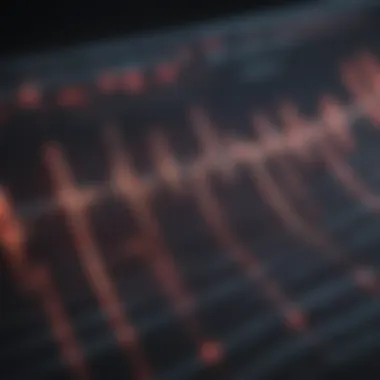Understanding Abnormal EKG Readings in Depth


Intro
Understanding the complexities of electrocardiograms (EKGs) can feel like navigating a maze without a map. In today’s fast-paced medical world, abnormal EKG readings are becoming increasingly relevant for both healthcare professionals and the curious layman. Each wave, interval, and segment on an EKG can tell a different story about a patient’s heart health. However, interpreting these readings is not always straightforward, often requiring a keen eye and a wealth of knowledge.
The aim of this article is to peel back the layers on abnormal EKG examples, shedding light on issues that might otherwise be tangled and confusing. From recognizing common irregularities to understanding their potential implications, we take a deep dive into the realm of cardiac monitoring.
Just as every cloud has a silver lining, each abnormal EKG presents a chance for insight and, ultimately, improvement in patient care. Through detailed examples, we hope to clarify the significance of these irregular patterns while also catering to a wide audience, from seasoned cardiologists to intrigued students. Armed with this information, readers will be better equipped to face the complexities of cardiac assessments.
In the sections that follow, expect a blend of theory and practical observations that aim to enhance your understanding and appreciation of EKG readings.
Preamble to EKG Interpretation
In the realm of cardiology, the ability to interpret electrocardiograms (EKGs) serves as a fundamental skill, bridging the gap between complex cardiac functions and practical patient care. As a healthcare provider or a medical student, understanding the nuances of EKG interpretation is essential for effective diagnosis and treatment pathways. This section provides a roadmap to navigate the intricate world of EKGs, emphasizing their significance and the foundational concepts that underpin the practice.
The Importance of EKGs in Cardiology
EKGs are like a window into the heart’s rhythmic behavior. They reveal much more than just the beats per minute; they depict electrical impulses, providing insight into how well the heart is functioning. The readings can indicate critical conditions such as arrhythmias, myocardial infarctions, or electrolyte imbalances. In many cases, such abnormalities can guide treatment decisions or alert practitioners to impending emergencies.
Understanding EKGs is indispensable for various medical professionals:
- Cardiologists rely on EKGs to confirm diagnoses.
- Emergency room staff utilize EKG interpretations to handle acute situations promptly.
- Nurses also play a significant role, monitoring EKGs daily to catch changes in patients’ cardiac status.
The significance of EKGs extends beyond emergency scenarios as well. They are crucial for monitoring patients with chronic conditions, assisting in preventive care, and evaluating the effectiveness of treatments over time. Thus, for anyone engaged in cardiovascular medicine, a solid grounding in EKG interpretation is non-negotiable.
Basics of Electrocardiography
Electrocardiography isn’t just about reading lines on a page; it’s a study of electrical activity in the heart through electrodes placed on the skin. This technique captures the heart's complex, dynamic rhythm and translates it into a readable format. Here’s a brief dive into the basics:
- Lead Placement: Correct electrode placement is paramount. Standard 12-lead EKGs provide a comprehensive view of the heart's electrical activity from different angles.
- Waveforms: EKGs display distinct waveforms: P waves, QRS complexes, and T waves, each correlating with specific electrical events in the cardiac cycle. For instance, the P wave signifies atrial depolarization, while the QRS complex indicates ventricular depolarization.
- Intervals and Segments: Important intervals, such as the PR interval and QT interval, are patterned indicators that help assess the heart's electrical systems. Abnormalities in these can hint toward significant underlying issues.
"Comprehensive knowledge of EKG basics can prevent false interpretations that may lead to incorrect clinical decisions."
By grasping these foundational concepts of electrocardiography, practitioners become equipped to decode and analyze EKG patterns accurately. It sets the stage for a deeper investigation into both normal and abnormal findings, illustrating why clear interpretation skills are crucial in clinical practice.
Understanding Normal EKG Patterns
Understanding how to identify normal EKG patterns is critical for anyone in the medical field. By having a solid grip on what constitutes a normal EKG, healthcare professionals can spot abnormalities more easily. This foundational knowledge is not just for cardiologists; it's also vital for general practitioners, emergency room staff, and even students specializing in healthcare. The implications of accurately reading these patterns stretch far beyond academic interest; they influence patient diagnosis, treatment plans, and ultimately, patient outcomes.
Key Components of a Standard EKG
In the realm of electrocardiography, certain key features form the backbone of our understanding of normal EKGs. These components include:
- P wave: This tiny bump signifies atrial depolarization, which is the electrical activity spreading through the atria, readying them for contraction.
- QRS complex: A sharp spike representing ventricular depolarization. It's typically brief but indicates that the ventricles are gearing up to pump blood.
- T wave: This wave indicates ventricular repolarization, as the electrical activity returns to its baseline, preparing the heart for another cycle.
- PR interval: The duration from the start of the P wave to the start of the QRS complex, usually between 120 and 200 milliseconds.
- QT interval: This time spans from the beginning of the QRS complex to the end of the T wave, encapsulating the period of depolarization and repolarization in the ventricles.
Each of these components has specific ranges and should be observed for any deviations that might indicate underlying conditions. Understanding how these waves interact gives healthcare professionals powerful insights into heart health.
Interpreting Normal EKG Tracings
Interpreting standard EKG tracings isn't rocket science, but it does require attention to detail. A typical rhythm usually demonstrates a consistent pattern; this regularity is what distinguishes a normal EKG from an abnormal one. Consider the following aspects while interpreting the tracings:
- Heart Rate: A normal heart rate tends to hover between 60 to 100 beats per minute. Anything outside this range might raise eyebrows and warrants further investigation.
- Rhythm Regularity: Normal EKGs exhibit consistent spacing between R waves in the QRS complex. An irregular rhythm can indicate arrhythmias or other cardiac issues.
- Wave Morphology: The shapes and sizes of the waves must be consistent across the tracing. For example, an abnormally tall peak in the T wave could indicate electrolyte imbalances or other complications.
Understanding how to measure these elements can dramatically affect diagnostic outcomes. An EKG that appears normal at first glance may reveal issues upon closer scrutiny, so always double-check your observations.
Ultimately, mastering the nuances of normal EKG patterns serves as a vital skill for interpreting the full spectrum of cardiac rhythms and potential abnormalities. Knowledge in this area allows for prompt and effective medical interventions, reducing the chance of adverse outcomes.
Common Abnormal EKG Findings
Understanding common abnormal EKG findings is vital in the intricate world of cardiology. They serve as red flags, indicating potential underlying issues that can significantly impact a patient’s health. When interpreting EKGs, a healthcare practitioner must recognize these abnormalities not just as standalone phenomena but within the broader context of a person’s clinical picture. This awareness allows for timely intervention, potentially saving lives and improving outcomes.
Arrhythmias: Recognition and Examples


Arrhythmias refer to irregular heartbeats, and they can manifest in various forms. Some examples include atrial fibrillation, which often presents as an erratic, rapid heartbeat, and may result in symptoms like palpitations and fatigue. Recognizing these patterns on an EKG is crucial.
For instance, in atrial fibrillation, the EKG may show no distinct P waves and an irregularly irregular rhythm. This can lead to increased risk for stroke or heart failure if left unchecked. Practitioners often utilize the term "irregular heartbeat" when describing EKG patterns seen in arrhythmias.
Another example is ventricular tachycardia, identifiable by a series of wide, tall QRS complexes without visible P waves. This type of arrhythmia can be life-threatening and necessitates immediate medical attention.
Arrhythmias show that the heart’s electrical signals may be going on a bit of a wild goose chase, leading to chaos in the rhythm that could have serious consequences.
Hypertrophy Indicators in EKGs
Hypertrophy in heart muscles indicates thickening due to an increased workload, often stemming from high blood pressure or other underlying conditions. The EKG can showcase signs of hypertrophy, offering insight into the heart's performance. For example, left ventricular hypertrophy can often be detected through increased amplitude in the QRS complexes, particularly in precordial leads.
Additionally, the presence of left atrial enlargement may present with a biphasic P wave in lead V1. These indicators do not just highlight an anatomical change; they suggest that vigilance is required to manage the conditions leading to hypertrophy, as continued stress may ultimately lead to heart failure.
Ischemic Changes: Classifying Types
Ischemic changes visible on an EKG indicate that parts of the heart may not be receiving adequate blood flow, often due to blockages in the coronary arteries. The classification here is crucial and often includes elevated ST segments, which can indicate an ST-elevation myocardial infarction, or ST elevation MI, commonly referred to simply as an ST-elevation event.
In contrast, ST segment depression might suggest angina or an ongoing ischemic episode without full-blown infarction. Understanding these variations allows clinicians to prioritize patient care.
Employing a systematic approach to identify these ischemic changes enhances diagnosis accuracy and ultimately affects treatment pathways.
Case Studies of Abnormal EKG Patterns
In the realm of cardiology, case studies play a vital role in enhancing our understanding of abnormal EKG patterns. By examining real-world examples, we can connect theoretical knowledge to practical scenarios, leading to better diagnostic capabilities and patient outcomes. These case studies illuminate the nuances of abnormal readings, allowing healthcare professionals to recognize subtle differences that may indicate underlying cardiac issues. Additionally, these examples foster discussions about differential diagnoses, treatment strategies, and the forecasting of potential complications. It's about more than just identifying a rhythm; it’s about piecing together the puzzle of a patient's heart.
Atrial Fibrillation: An EKG Example
Atrial fibrillation (AF) stands as one of the most prevalent types of arrhythmia encountered in clinical practice. On an EKG, this condition is depicted by an irregularly irregular rhythm, often accompanied by absent P waves. Instead of the classic sinus rhythm, doctors will see rapid and chaotic electrical activity in the atria. Understanding this pattern is crucial since AF increases the risk of thromboembolic events, like strokes.
A specific case may feature an older patient, presenting with palpitations and fatigue. The EKG reveals the characteristic rapid, disorganized electrical activity.
"The irregularity could be a signal of deeper underlying issues, requiring immediate attention and further investigation."
It's essential to manage AF effectively, often involving anticoagulation therapy and rate control, making the recognition of this pattern not just a matter of academic interest, but a life-saving endeavor.
Ventricular Tachycardia: Diagnostic Insights
Ventricular tachycardia (VT) presents a more pressing clinical picture. Its rapid sequence of beats—often exceeding 100 beats per minute—inherits a serious risk of progressing to ventricular fibrillation. The EKG shows wide QRS complexes, signifying a disturbance originating from the ventricles.
For instance, take the case of a middle-aged man with a history of coronary artery disease who arrives at the ER with chest pain and dizziness. The EKG displays regular, wide complexes at a rapid rate. Recognizing this pattern allows immediate intervention, potentially using medications or even electrical cardioversion to restore a normal rhythm. Here, identifying the specific EKG features and correlating them with clinical presentation is paramount. The insights gleaned from such a case underscore the critical nature of a timely diagnosis.
ST Elevation Myocardial Infarction: EKG Indicators
ST elevation myocardial infarction (STEMI) serves as another high-stakes EKG pattern. It represents a critical reduction in blood flow through the coronary arteries, requiring urgent medical intervention. The EKG findings include elevated ST segments across contiguous leads, indicating ischemia of the heart muscle.
Imagine a young adult experiencing severe chest pain accompanied by sweating and shortness of breath. An EKG would illustrate the tell-tale elevations in specific leads, leading to a swift decision for reperfusion therapy—often via angioplasty. Quick recognition of this pattern can drastically improve outcomes, making it not only a technical skill but a crucial lifesaving one.
Rare EKG Abnormalities
Rare EKG abnormalities hold a critical place in the realm of electrocardiography. Understanding these irregularities can be the key to unlocking complex cardiac conditions that don’t often present in typical scenarios. While some EKG findings are commonplace and easily recognizable, rare patterns offer unique challenges and opportunities for deeper investigation.
These rarer EKG anomalies draw attention due to their often subtle presentations, which can easily be overlooked in routine assessments. The implications of misinterpretation can be serious, potentially leading to misdiagnosis or inappropriate treatment strategies. Thus, familiarity with these abnormalities is vital for clinicians, cardiologists, and even those in training.
Brugada Syndrome and Its EKG Features
Brugada Syndrome is not just a mouthful but an important heart condition that can go unnoticed, leaving patients at risk of life-threatening arrhythmias. EKG features indicative of this syndrome include a characteristic Type 1 pattern, which displays a coved ST-segment elevation in the right precordial leads (V1-V3). This pattern can resemble the rolling waves of the sea, effortlessly hiding its severity under the surface.
The condition is hereditary in most cases, stemming from mutations in cardiac sodium channel genes. Unfortunately, it can lead to ventricular fibrillation or sudden cardiac arrests, particularly during sleep or in hot weather. Recognizing this pattern on an EKG is crucial; timely identification can mean the difference between life and death.
Besides the classic ST-segment elevation, other notable features may include:


- Right bundle branch block (RBBB)
- Conduction delays
- Possible concomitant arrhythmias
Awareness of Brugada Syndrome is especially important for those working in emergency medicine or cardiology, as patients may not show any symptoms until a serious event unfolds. Monitoring and further genetic testing can play vital roles in managing patients diagnosed with this syndrome.
"Understanding rare syndromes like Brugada can significantly improve patient outcomes, especially when traditional EKG interpretations fall short."
Long QT Syndrome: Risk Factors and Signs
Long QT Syndrome (LQTS) is another rare but serious condition that can manifest through abnormal EKG readings. This condition increases the risk of arrhythmias like Torsades de Pointes, potentially leading to syncope or even sudden cardiac death. The hallmark on the EKG is a prolonged QT interval, but this anomaly often escapes basic EKG evaluations.
A range of factors can influence the development of Long QT Syndrome, notably including:
- Genetic predispositions
- Electrolyte imbalances (like low potassium or magnesium)
- Certain medications (such as some antipsychotics and antibiotics)
- Underlying structural heart diseases
It’s not uncommon for clinicians to find patients who present with unexplained syncope to possess prolonged QT intervals that go unnoticed on initial reviews. Key indicators of LQTS on an EKG may include:
- QTc>450 ms in males and >460 ms in females, which indicates an effective heart rate handling.
- T-wave abnormalities, which can show a characteristic notched appearance.
Patients might not always show symptoms, making it paramount for physicians to consider LQTS a possibility when the risk factors align. Continued education, vigilance in EKG interpretation, and patient history are crucial in identifying this condition early and preventing catastrophic events.
In summary, both Brugada Syndrome and Long QT Syndrome illustrate the significant role that rare EKG abnormalities play in patient care. A keen eye for these patterns can allow for earlier, potentially life-saving interventions.
Impact of Technology on EKG Interpretation
Technology has dramatically shifted the landscape of EKG interpretation. The evolution of devices and analytical methodologies have facilitated a deeper understanding of cardiac health. By studying abnormal EKG patterns, clinicians can pinpoint concerns earlier and with increased accuracy. For both seasoned medical professionals and students alike, it’s vital to grasp how technology enhances EKG interpretation.
Specific Elements of Technological Impact
- Increased Accuracy: With the advent of advanced monitoring devices, precision in capturing and reading EKGs is significantly higher. Technologies like Holter monitors and event recorders allow for continuous tracking of heart activity.
- Remote Monitoring: Devices such as smart wearables enable patients to be monitored from afar, making it easier for healthcare providers to assess conditions without patients needing to be physically present.
- Data Analysis Tools: New software solutions leverage machine learning to identify abnormal patterns with remarkable speed. These tools analyze large datasets, taking into account not just individual patient data but also broader epidemiological trends.
- Ease of Use: Modern devices often come with user-friendly interfaces. Training for healthcare staff becomes less burdensome as these examples are more intuitive and straightforward to operate.
While the benefits of technological advancements are clear, considerations must not be overlooked. Security of patient data remains paramount with any digital tool. Integration of these technologies into clinical practices also necessitates ongoing training to ensure that all users are comfortable with the latest updates and features.
Advancements in EKG Monitoring Devices
As the cardiology field progresses, the enhancements in EKG monitoring devices are nothing short of groundbreaking. Notable advancements have unveiled solutions with capabilities that were once thought impossible. Among the most significant developments are:
- Wearable Devices: These include wristbands and patches that continuously monitor heart rhythms. The convenience of wearing a device that tracks EKG data in real time means that abnormalities can be captured as they happen, assigning meaning to symptoms that might have previously gone unreported.
- Smartphone Applications: Mobile applications allow for quick EKG readings, facilitating immediate feedback to users. This democratization of heart health monitoring empowers individuals, providing them insights directly on their smartphones.
- Advanced Sensors: Innovations in sensor technology have produced smaller, more efficient devices capable of delivering precise readings, even during movement. This makes it easier to monitor patients who lead active lifestyles.
These advancements illustrate a clear shift towards personalized medicine, with individuals benefiting from more tailored and timely interventions.
AI in EKG Analysis: Enhancements and Limitations
The integration of artificial intelligence into EKG analysis has marked a revolutionary phase in cardiac care. AI algorithms enhance the ability to process large amounts of data rapidly, thus identifying potential issues quicker than traditional methods. But, like every silver lining, it carries shadows too.
- Enhancements:
- Limitations:
- Speed: AI can analyze EKG results in a fraction of the time it takes a human, allowing for instant clinical decision-making.
- Pattern Recognition: With machine learning, AI applications improve over time, refining their ability to spot abnormalities that might elude the human eye.
- Predictive Analytics: AI can sift through vast datasets, recognizing trends that signal emerging risks, thereby allowing for preventive measures.
- Dependence on Quality of Data: AI's efficacy is contingent on the quality and quantity of data fed into it. Insufficient or biased data can lead to misinterpretations.
- Interpersonal Skills: AI aids interpretation but cannot replace the human touch necessary in diagnosing and addressing health concerns.
- Ethical Considerations: Patient confidentiality and data security become pressing issues when employing AI technologies, necessitating rigorous regulatory frameworks.
In summary, while AI propels EKG analysis forward, its deployment must be cautious and deliberate, ensuring that it complements rather than replaces human expertise.
"Technology in cardiology isn't just a tool; it's a partner in preserving heart health."
Understanding the impact of these technological advancements is crucial for both practitioners and patients as we embrace the future of cardiac care. The blend of tech and human insight cultivates a holistic approach to heart health.
Clinical Significance of Abnormal EKGs
Abnormal EKGs are not just numbers and lines; they hold the key to understanding a patient’s heart health. The ability to interpret these irregularities can lead to early detection of severe conditions, which can drastically improve patient outcomes. Recognizing abnormal patterns provides a roadmap for healthcare providers. It’s about piecing together the puzzle, where each irregularity may signify an underlying issue that warrants attention.
The significance of abnormal EKG readings extends beyond immediate diagnosis. It influences treatment and management strategies for patients. Understanding the prognostic value embedded in specific patterns can help clinicians anticipate possible complications.


Additionally, abnormal findings can raise red flags, prompting additional diagnostic tests or interventions that could save lives. In a way, it’s not merely about the heart but about putting together a patient’s story through their EKG findings.
Prognostic Value of Specific Patterns
The prognostic value of specific patterns in EKG can often be the difference between life and death. For instance, a prolonged QT interval can be indicative of potential arrhythmias. This information is not just academic. Knowing these patterns can alert a physician to the necessity of monitoring. Moreover, certain patterns, such as ST elevations, can signal an impending myocardial infarction, necessitating urgent care.
There are also numerous other abnormalities to keep an eye on. Here are some notable examples:
- Atrial Fibrillation: This condition can lead to stroke if not managed properly. Recognizing it quickly is critical.
- Ventricular Hypertrophy: Patterns can indicate left or right ventricular hypertrophy, which may suggest chronic pressure overload.
- Bradycardia or Tachycardia: Both conditions can lead to serious hemodynamic instability if not monitored.
Understanding these patterns is crucial; they can be the compass guiding a physician’s clinical decisions.
Implications for Patient Management
When it comes to managing patients based on EKG findings, the implications extend to treatment plans, lifestyle adjustments, and ongoing monitoring strategies. Effective interpretation aids in tailoring personalized treatment plans, allowing healthcare professionals to address the underlying causes rather than merely treating symptoms. For example, a patient showing signs of ischemia might require not just medications, but lifestyle changes, like diet and exercise adjustments, to rectify risk factors.
Moreover, abnormal EKG findings often necessitate further investigations such as echocardiograms or stress tests to clarify the nature of the irregularity. This multi-faceted approach can facilitate better patient outcomes.
In therapeutic situations, specific findings can also dictate the urgency of intervention. A swift approach is critical. Time-sensitive situations like arrhythmias or signs of ischemia require readiness for immediate action. This readiness directly correlates with the potential to save lives and enhance quality of care, underscoring the profound connection between EKG analysis and patient management outcomes.
In summary, the clinical significance of abnormal EKGs cannot be understated. Their interpretation not only sheds light on immediate cardiovascular risks but also paves the way for targeted and effective patient management.
Future Directions in EKG Research
In the rapidly evolving landscape of cardiology, the realm of EKG research is pivotal. The importance of investigating new frontiers in this field cannot be overstated. With ongoing advancements, researchers strive to unlock mysteries surrounding abnormal EKG patterns and their implications for patient care. These developments not only enhance our understanding of cardiac mechanisms but also pave the way for more effective diagnostic tools, enabling clinicians to intervene sooner and with greater precision.
Emerging Research on EKG Abnormalities
Research into EKG abnormalities is gaining traction, revealing nuances previously overlooked. Emerging studies focus on a range of issues — from genetic predispositions to specific arrhythmias, to the influence of lifestyle factors on EKG readings. For instance, researchers are starting to dissect how anxiety and physical stress manifest in EKG changes, offering insights for better patient management.
There are several key areas of inquiry:
- Genomic Studies: The link between genetic markers and abnormal EKGs is a focal point. By identifying these markers, practitioners may predict the likelihood of heart diseases.
- Machine Learning Models: Utilizing artificial intelligence to analyze EKG data offers the potential for real-time anomaly detection.
- Longitudinal Studies: Observing EKG changes across various populations over time helps to establish what variations might be considered normal or indicative of serious pathology.
These emerging research strands create a foundation for understanding EKG abnormalities in a way that is more personalized and precise, leading to tailored treatments that address individual needs.
Potential Innovations in EKG Technology
Technological innovation continues to shape how we gather and interpret cardiac data. EKG technology is on the brink of substantial transformation, driven by the steady march of progress. One significant aspect involves the development of portable devices that allow for continuous monitoring—an essential feature for patients with known heart issues or at risk for sudden complications.
Innovations can be seen in
- Wearable Devices: Modern smartwatches and fitness trackers now come equipped with EKG monitoring capabilities, enabling users to keep an eye on their heart health right from their wrist.
- Remote Monitoring Systems: Telehealth tools are increasingly incorporating EKG technology, allowing healthcare providers to monitor their patient's cardiac health in real-time, thus reducing the need for frequent in-clinic visits.
- Enhanced AI Algorithms: A more sophisticated approach to AI is emerging that can analyze vast amounts of EKG data, offering insights that could change the course of treatment uniquely tailored to each patient's circumstances.
As these technologies evolve, the potential for improved outcomes through precise and rapid identification of cardiac issues becomes more tangible.
"We are entering an era where EKG monitoring and interpretation will be as ubiquitous as checking the time on a watch."
By harnessing these innovations, the medical community is likely to enter a new phase of cardiac care, wherein timely intervention based on accurate interpretations of EKG readings can literally make the difference between life and death.
End
In navigating the complexities of abnormal EKG readings, it becomes evident just how pivotal our discussion has been throughout this article. Understanding abnormal patterns isn't merely an academic exercise; it carries real weight in clinical settings. The recognition of these nuances allows for swift diagnosis and, ultimately, better patient outcomes. Misinterpretation of EKG signs can lead to inadequate treatment, so the thorough examination we've undertaken is vital.
Summary of Key Findings
The journey through the world of EKGs has highlighted several important points:
- Key Abnormalities Identified: We’ve explored various abnormal EKG patterns such as atrial fibrillation and ventricular tachycardia, each with distinct implications for patient health.
- Impact of Technology: Advancements in EKG interpretation tools, including AI applications, have transformed how we analyze cardiac data, improving accuracy and timeliness.
- Clinical Relevance: Each abnormality discussed ties back to clinical consequences, underscoring the importance of precise interpretation in patient management.
"A comprehensive EKG analysis can save lives; it isn't just about numbers but understanding the heart's story."
Final Thoughts and Recommendations
To wrap up, the importance of continuous learning in the realm of EKG interpretation cannot be overstated. Practitioners should remain vigilant and embrace new research findings that illuminate the understanding of EKG abnormalities. Education and correct application of knowledge are paramount; hence, further resources and potential workshops or training could of great value.
- Stay Updated: Keeping abreast of the latest studies on cardiac health is crucial.
- Utilize Resources: Engage with platforms such as Wikipedia and Britannica for ongoing education.
- Collaborate: Encourage interdisciplinary cooperation among cardiologists, nurses, and technologists for a holistic view on EKG readings.
In summation, grasping the complexity of abnormal EKG interpretations is indispensable for any professional involved in heart health. Understanding not just the 'what' but also the 'why' can make all the difference in both diagnosis and patient care.



